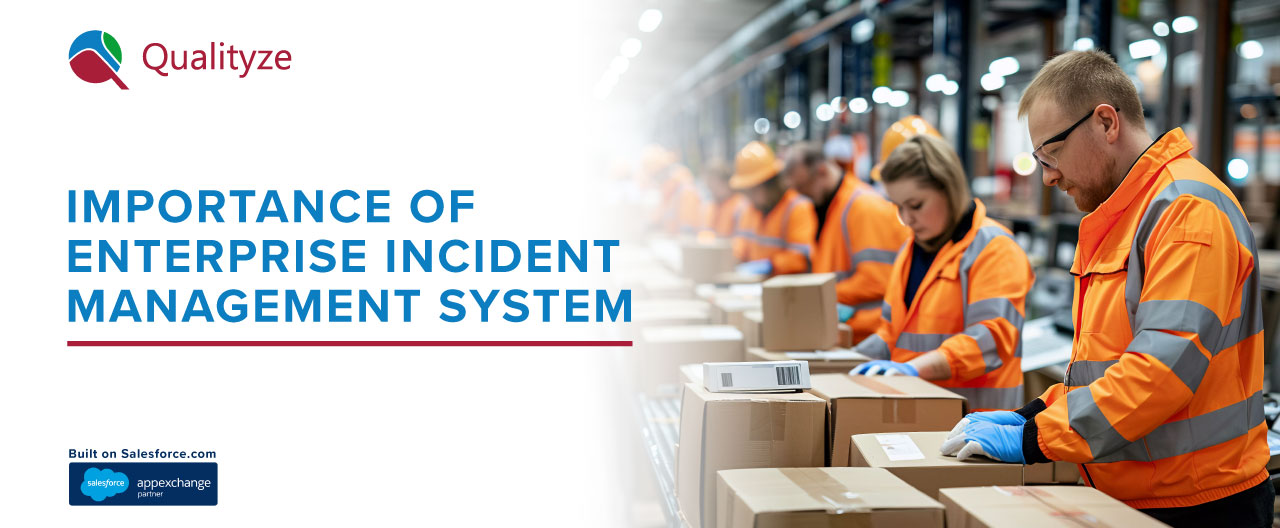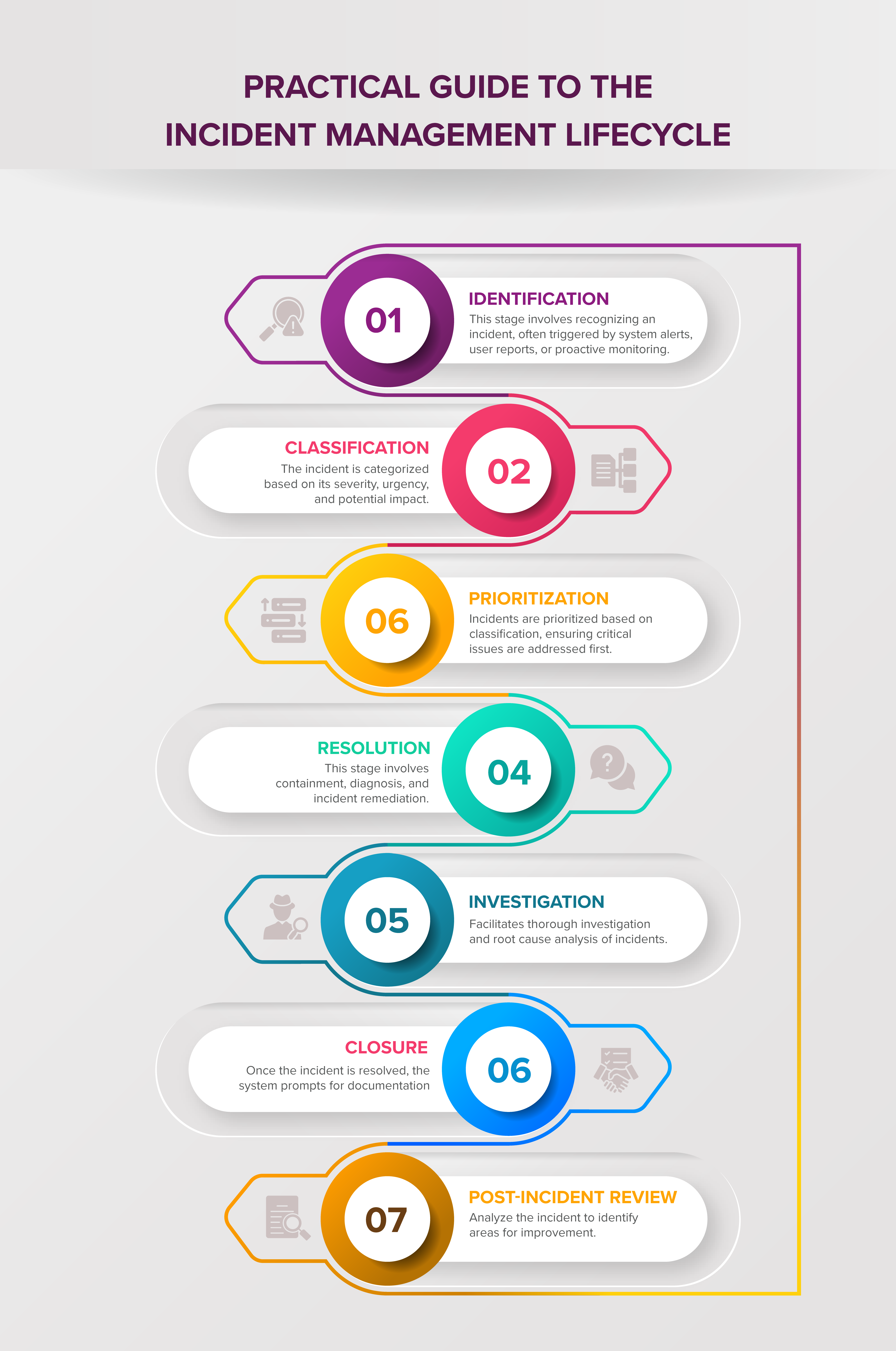Table of Content
1 The Main Purpose of Incident Management
2 At its core, Enterprise incident management system seeks to:
3 Practical Guide to the Incident Management Lifecycle
4 What are the Types of Incident Management?
There are various types of incident management, each tailored to address specific types of disruptions:
6 Benefits of Implementing Incident Management
7 Challenges of Incident Management
8 Cloud-Based Incident Management for EHS:
9 Healthcare Incident Management Overview
Quality Improvement
Practical Implementation in Healthcare
12 Parting Shot:

From slips and falls to security breaches to near misses, unexpected events can significantly impact employee safety, health and business operations,. A robust Enterprise Incident Management system (EIM) ensures efficient management of incidents, facilitates thorough investigations and root cause analysis, and enables the implementation of corrective and preventive actions ensuring safety, compliance, and continuous improvement.
The Main Purpose of Incident Management
The primary goal of the Enterprise Incident Management System is to ensure the safety and health of employees, contractors, and visitors by promptly addressing and mitigating incidents such as accidents, near misses, and hazardous conditions.
Incident management system is a systematic approach to identifying, classifying, prioritizing, resolving, and learning from incidents. Its objective is to efficiently manage and respond to incidents to ensure the safety and health of employees, regulatory compliance requirements, protection of the environment, and minimizing the impact on business operations.
At its core, Enterprise incident management system seeks to:
- Identify and categorize incidents: This involves a standardized way to report, document, and categorize incidents, ensuring that all necessary information is captured accurately and consistently.
- Respond quickly: Promptly address and mitigate incidents such as accidents, near misses, and hazardous conditions.
- Corrective and Preventive Actions: It helps in planning, tracking, and implementing corrective and preventive actions to address identified issues and mitigate future risks.
- Communicate effectively: Ensures effective communication and coordination among different departments and stakeholders during an incident response, minimizing confusion and delays.
- Learn and improve: By continuously monitoring and analyzing incidents, organizations can improve their EHS programs and policies, fostering a culture of safety and continuous improvement.
- Training and Awareness: It helps in identifying training needs and raising awareness among employees about safety practices and procedures.
Practical Guide to the Incident Management Lifecycle
Most EIM systems follow a standardized Enterprise incident management system lifecycle, typically consisting of five stages:

- Identification: This stage involves recognizing an incident, often triggered by system alerts, user reports, or proactive monitoring.
- Classification: The incident is categorized based on its severity, urgency, and potential impact.
- Prioritization: Incidents are prioritized based on classification, ensuring critical issues are addressed first.
- Resolution: This stage involves containment, diagnosis, and incident remediation. The EIM system may provide tools for collaboration, knowledge sharing, and documentation to facilitate resolution.
- Investigation and Analysis: It facilitates thorough investigation and root cause analysis of incidents to identify underlying causes and prevent recurrence.
- Closure: Once the incident is resolved, the system prompts for documentation, lessons learned, and post-incident reviews for continuous improvement.
- Post-Incident Review: Analyze the incident to identify areas for improvement. This helps refine incident management processes and prevent future occurrences.
What are the Types of Incident Management?
There are various types of incident management, each tailored to address specific types of disruptions:
Incident management can be categorized into several types based on the nature and severity of incidents:
Safety Incidents:
- Accidents: Unplanned events that result in injury or damage, such as slips, trips, falls, and machinery accidents.
- Near Misses: Events that could have resulted in injury or damage but did not, providing an opportunity to prevent future incidents.
- Hazardous Conditions: Situations or conditions that pose a risk of injury or damage, such as unsafe work practices or defective equipment.
Health Incidents:
- Occupational Illnesses: Health conditions caused by exposure to harmful substances or environments at work, such as respiratory diseases from inhaling toxic fumes.
- Ergonomic Injuries: Injuries resulting from poor workstation design or repetitive motion, such as carpal tunnel syndrome or back pain.
Environmental Incidents:
- Spills and Leaks: Release of hazardous substances into the environment, such as chemical spills or oil leaks.
- Pollution: Incidents causing air, water, or soil contamination, like emissions of harmful gases or improper waste disposal.
Security Incident
- Theft and Vandalism: Incidents involving the unauthorized taking or damaging of property.
- Unauthorized Access: Incidents where unauthorized individuals gain access to restricted areas or information.
- Cyber Attacks: Attempts to compromise systems, including malware infections, phishing attacks, and ransomware.
- Data Breaches: Unauthorized access to sensitive data, leading to potential data loss or theft.
Fire Incidents:
- Fires: Outbreaks of fire in the workplace, which can cause injuries, fatalities, and significant property damage.
- Explosions: Incidents involving the explosion of materials or equipment, often resulting in severe consequences.
Benefits of Implementing Incident Management
Implementing an effective incident management system offers numerous benefits:
- Improved Service Availability: Quickly addressing and resolving incidents minimizes downtime, ensuring services remain available to users.
- Enhanced Customer Satisfaction: Effective communication and prompt resolution increase user satisfaction and trust
- Operational Efficiency: Streamlined processes and clear protocols enable efficient incident handling, reducing wasted time and resources.
- Increased Productivity: Minimizing the impact of incidents on employees’ work enables them to maintain productivity and focus on their core tasks.
- Better Risk Management: Proactive incident management helps identify potential risks early, allowing for mitigation before they escalate.
- Compliance and Reporting: Maintaining detailed records of incidents and resolutions aids regulatory compliance and reporting.
- Enhanced Security Posture: Effective incident management practices help identify and address security vulnerabilities, minimizing the risk of attacks.
- Improved Communication and Collaboration: EIM systems provide a central platform for team communication and collaboration during incident response.
- Continuous Improvement: By analyzing incident data, organizations can identify trends, improve processes, and prevent future incidents.
- Proactive Incident Management: By identifying and analyzing incident trends, organizations can address underlying issues, preventing future incidents and improving overall system stability.
Related Article: Best Practices to Proactively Manage Workplace Incidents
Challenges of Incident Management
Despite the benefits, implementing and maintaining effective incident management presents some challenges:
- Resource Constraints: Allocating dedicated personnel and training them on EIM systems can be resource-intensive for some organizations.
- Complexity of Modern IT Environments: The increasing complexity of IT systems and networks makes incident detection and resolution more challenging.
- Communication Gaps: Poor communication between teams and stakeholders can delay incident resolution and create confusion.
- Standardization and Integration: Integrating EIM systems with existing IT infrastructure and ensuring consistent processes across departments can be complex.
- Continuous Learning and Adaptation: Incident management requires ongoing learning and adaptation to evolving threats and technologies.
- Maintaining Up-to-Date Knowledge: EIM systems require regular updates to adapt to evolving threats and vulnerabilities.
- Change Management: Implementing a new EIM system necessitates a cultural shift within the organization for successful adoption.
Cloud-Based Incident Management for EHS:
Cloud-based Incident Management is one of the most risk-proof solutions for Environmental, Health, and Safety (EHS), offering a future-ready solution tailored for managing incidents. It is especially beneficial for organizations with teams spread across different locations. Some of the notable features offered by these solutions include:
- Scalability and Flexibility: Cloud-based EHS systems can scale with the organization's needs, offering flexible solutions for incident management.
- Real-Time Data Access: Access incident data in real-time from anywhere, facilitating faster response and resolution.
- Integration with Other Systems: Cloud-based EHS can integrate with other enterprise systems, improving overall incident management efficiency.
- Cost-Effectiveness: Reduced upfront costs and pay-as-you-go models make cloud-based solutions affordable for organizations of all sizes.
- Enhanced Collaboration: Facilitate collaboration among dispersed teams, ensuring everyone has access to the same information and tools.
- Centralized Incident Reporting: Easy-to-use interfaces allow employees to report incidents from anywhere, anytime.
- Automated Workflows: Streamline incident response with automated notifications, approvals, and escalation procedures.
- Data Analytics and Reporting: Gain valuable insights from incident data to identify trends and prevent future occurrences.
- Mobile Accessibility: Access incident management tools and reports from mobile devices for on-the-go responsiveness.
Healthcare Incident Management Overview
Healthcare organizations face unique challenges in incident management. Patient safety requires a meticulous approach to identifying, reporting, and analyzing medical errors and adverse events. EIM systems in healthcare settings:
- Facilitate Patient Safety Reporting: Provide secure and confidential channels for reporting medical errors and near misses.
- Track and Trend Incidents: Identify patterns and areas for improvement in patient care protocols.
- Enhance Communication and Collaboration: Facilitate communication between healthcare professionals to ensure a coordinated incident response.
- Reduce Risk of Legal Issues: Proper documentation of incidents can aid in legal defense in case of malpractice claims.
Quality Improvement
Incident management helps identify areas for improvement in healthcare delivery, leading to better patient outcomes.
Practical Implementation in Healthcare
Implementing incident management in healthcare involves:
- Training and Awareness: Ensuring all staff are trained in incident reporting and management procedures.
- Advanced Technologies: Using electronic health records (EHRs) and other technologies to track and manage incidents.
- Dedicated Teams: Establishing dedicated teams to handle different incidents, from clinical to IT-related.
Related Article: Improving Safety Incident Management with Integrated Document and Audit Control
Parting Shot:
Enterprise incident management system play a crucial role in maintaining organizational operations' stability, security, and efficiency. By understanding the lifecycle of incident management, the different types of incidents, and the benefits and challenges, organizations can better prepare to handle incidents effectively. Cloud-based EHS systems offer modern solutions for scalable and efficient incident management, while specialized approaches are necessary for industries like healthcare, where the stakes are particularly high. Implementing robust incident management practices ensures improved service availability, enhanced customer satisfaction, and better risk management, ultimately contributing to the organization's overall success.
Share
The Start of Something Amazing.
Request Demo
Products
Industries
Company